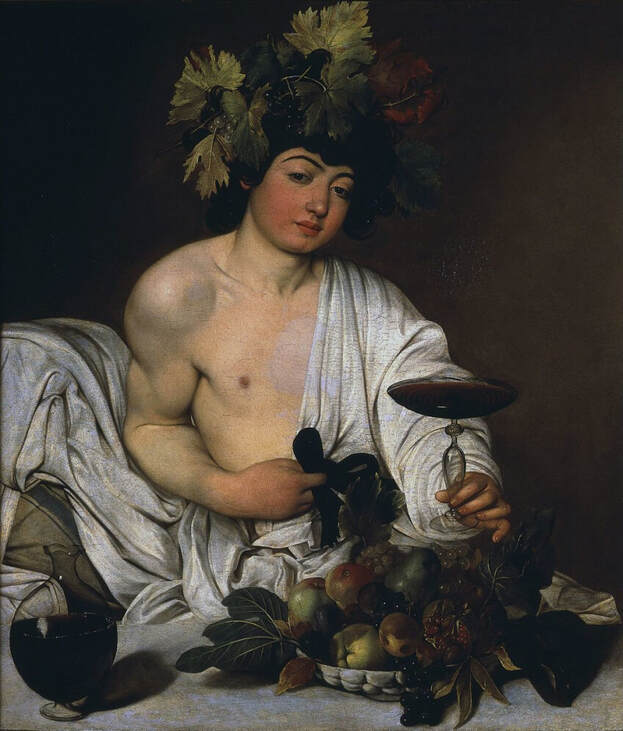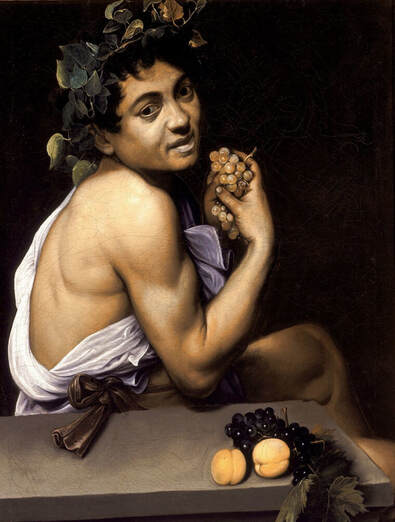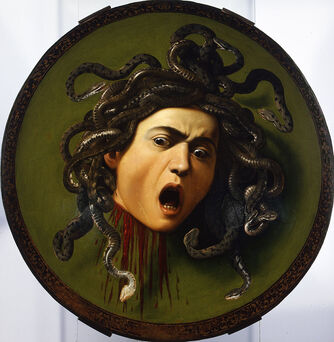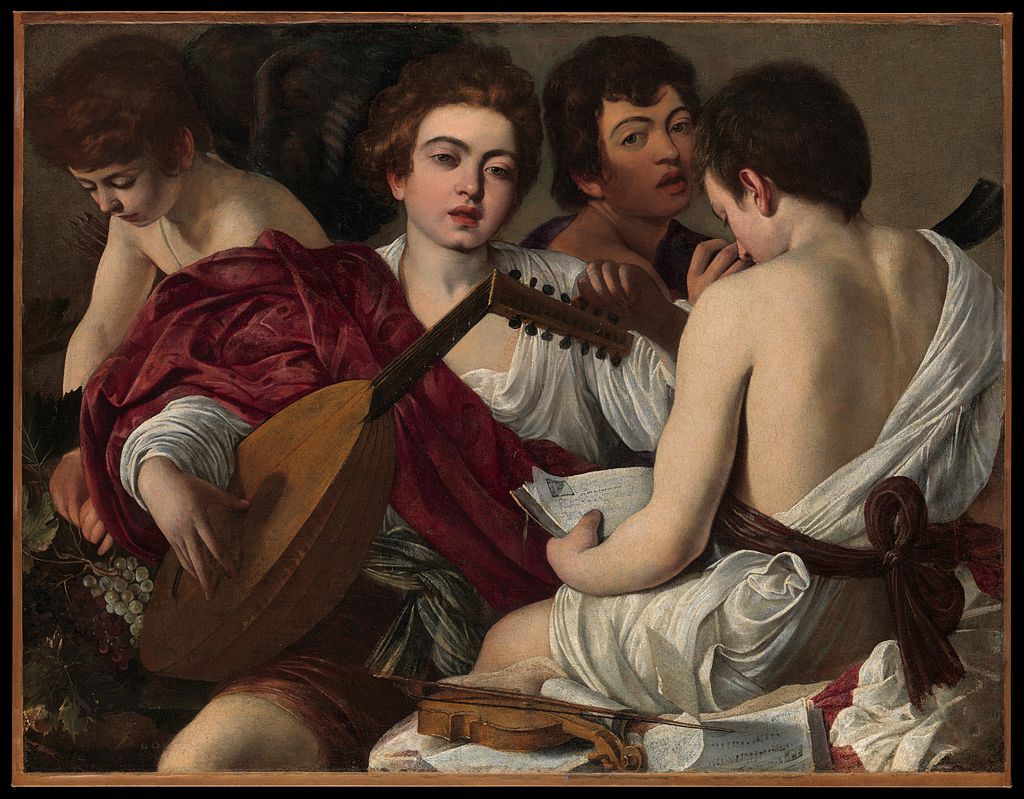|
Where? Room 97 of the Uffizi Museum
When? 1595-1598 Commissioned by? Cardinal del Monte, who gave it as a present to Ferdinando I de’ Medici, the Grand Duke of Tuscany. What do you see? A young Bacchus is holding a glass of wine in his left hand. He has a wreath of vine leaves and grapes on his head. It seems that he is wearing some makeup on his face. With his right hand, he is playing with the drawstrings of his half-opened robe. Bacchus is sitting on a chaise longue (a Roman type of chair/bench – also called a triclinium). On the stone table in front of him are a ceramic bowl of fruit and a jug of wine. The bowl of fruit contains both healthy and spoiled fruits as well as fresh green leaves and spoiled yellow leaves. Bacchus already seems a bit drunk and extends an invitation to the viewer to join him for a glass of wine and maybe something more… If you look carefully, you can see the ripples in the glass of wine to indicate the movement of the left arm of Bacchus towards the viewer. Backstory: This painting was created when Caravaggio was staying with his first patron, Cardinal del Monte in Rome. True to his unconventional style, Caravaggio painted an imperfect, limited, earthly version of Bacchus. This may be close to some of the figures he met in the many taverns and brothels that he liked to visit. Cardinal del Monte gave the painting away in 1608 to the Grand Duke of Tuscany on the occasion of the marriage of the Grand Duke’s son Cosimo II. The painting has long been unknown to the public as it stayed for centuries hidden in some of the private quarters of its owners. It was rediscovered in 1913 in the storage of the Uffizi Museum after which it was attributed to Caravaggio. Symbolism: The bowl with spoiled fruit is an example of a vanitas, which means ‘emptiness’. Vanitas refers in the traditional Christian view to the emptiness and worthlessness of all earthly goods and ambitions. Spoiled fruit is one common way to present this. It was appropriate to depict this fruit with Bacchus as he was associated with fertility and agriculture. Notice also the dirty fingernails of Bacchus. Some interpret this as a warning of the consequences of earthly pleasures, while other just attribute this to the style of Caravaggio (he painted in great detail what he saw, including dirty fingernails). The vine leaves in Bacchus’ hair are one of his sacred symbols, and that is how we can easily recognize him. Finally, it seems that Bacchus is wearing some makeup on his face, which is often associated with sexuality and strengthens the idea that he is inviting the viewer for more than a glass of wine. Who is Bacchus? Bacchus (in Greek Dionysus) is the god of the wine, fertility, madness, theatre, and religious ecstasy. He is the son of god Zeus and the mortal Semele.
Who is Caravaggio? Michelangelo Merisi da Caravaggio (1571-1610) was trained by Simone Peterzano, who was in turn trained by Titian. He used a realistic painting style, paying both attention to the physical and emotional state of the subjects he painted. He combined this with a brilliant contrast between light and shadow in his paintings.
Caravaggio had a tumultuous life and was accused of murder, assault, many fights, and he served in prison. However, his sheer brilliance as an artist has given him a place in the history books. His painting style has had a big influence on the development of Baroque painting (which includes drama and an intense contrast between light and dark). Among his many famous works are his Medusa in the Uffizi Museum and The Musicians in the Metropolitan Museum of Art.
Fun fact: Many experts believe that Caravaggio used a mirror to draw this painting such that he did not have to make the drawing first, but could immediately work on the painting. This means that the model for this painting offered the wine with his right hand, instead of the somewhat awkward way in which Bacchus is using his left hand. Another reason to believe that Caravaggio was using a mirror for this painting is that after a cleaning of the painting a very small self-portrait of Caravaggio working on a painting was revealed in the reflection of the jug of wine (but it is difficult to see).
Interested in a copy for yourself? Poster.
Written by Eelco Kappe
References:
3 Comments
6/16/2019 01:06:00 pm
Hello!
Reply
TripImprover
6/17/2019 01:10:59 pm
Hi Antonio,
Reply
Leave a Reply. |
Categories
All
|
- Home
- Blog
-
Museums
- Alte Pinakothek
- Art Institute of Chicago
- Baltimore Museum of Art
- Barber Institute of Fine Arts
- Bargello
- Barnes Foundation
- British Museum
- Church of Sant’Anastasia
- Cleveland Museum of Art
- Courtauld Institute of Art
- Detroit Institute of Arts
- Frans Hals Museum
- Galleria Borghese
- Gallerie dell'Accademia
- Getty Museum
- Guggenheim
- Hermitage Museum
- Kunsthistorisches Museum
- Kunstmuseum Basel
- Legion of Honor Museum
- Louvre
- Mauritshuis
- Metropolitan Museum of Art
- Musee d’Orsay
- Museum of Fine Arts in Boston
- Museum of Modern Art
- National Gallery in London
- National Gallery of Art
- National Museum in Poznań
- Norton Simon Museum
- Ny Carlsberg Glyptotek
- Palace of Versailles
- Palazzo Pitti
- Palazzo Vecchio
- Petit Palais
- Philadelphia Museum of Art
- Prado
- Pushkin Museum
- Ravenna Art Museum
- Rijksmuseum
- San Diego Museum of Art
- Santa Maria delle Grazie
- St. Peter's Basilica
- Städel Museum
- Statens Museum for Kunst
- Tate Britain
- Tate Modern
- Timken Museum of Art
- Uffizi
- Vatican Museums
- Wallace Collection
-
Artists
- Altdorfer
- Anguissola
- Berlin Painter
- Bosch
- Botticelli
- Boucher
- Bronzino
- Bruegel the Elder
- Brunelleschi
- Cabanel
- Caillebotte
- Canova
- Caravaggio
- Carpeaux
- Cezanne
- Cimabue
- David
- Degas
- Delacroix
- De Maria
- Donatello
- El Greco
- Fontana
- Fra Angelico
- Fragonard
- Gauguin
- Gentileschi
- Gericault
- Gonzalez-Torres
- Goya
- Hals
- Hogarth
- Hokusai
- Ingres
- Leonardo da Vinci
- Lippi, Filippo
- Longhi, Barbara
- Lorrain
- Makovsky
- Manet
- Massys
- Matisse
- Merian
- Michelangelo
- Mochi
- Modigliani
- Monet
- Panini
- Parmigianino
- Perugino
- Picasso
- Pisanello
- Raphael
- Rembrandt
- Renoir
- Reynolds
- Rivera
- Rodin
- Rubens
- Scultori
- Seurat
- Steen
- Tintoretto
- Titian
- Toulouse-Lautrec
- Turner
- Uccello
- Van der Weyden
- Van Dyck
- Van Eyck
- Van Gogh
- Van Hemessen
- Vasari
- Velazquez
- Vermeer
- Veronese
- Vigée Le Brun
-
Locations
- Books
- About Us




